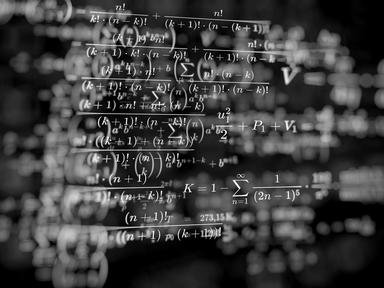Quiz Answer Key and Fun Facts
1. To begin with, let's try some arithmetic probability. If you're playing a game where you have two tries to guess a number between 1 and 10 (inclusive), what are the odds that you guess the number correctly in one of those two tries (assuming you don't guess the same number twice)?
2. Let's continue with some Algebra I. If you have a rectangular swimming pool of volume 105 m³ whose length is 2 meters longer than its width and whose depth is 2 meters shorter than its width, what is the perimeter (around the top) of the rectangular pool?
3. Let's move on to a little geometry. If you connect the midpoints of all four sides of a quadrilateral to create a new quadrilateral, that new quadrilateral will always be a parallelogram.
4. Next up, Algebra II: What would the set of all points satisfying the equation: √(y²) = √(x²)
(In the answers, abs(x) denotes the absolute value of x.)
5. Let's do some Precalculus. You've traveled in a motorboat 8 miles away from the dock (the origin) at a 30° angle above the shoreline (the x-axis). You then make a turn back toward the shore and travel exactly 5 miles so that your boat stops exactly on the shoreline.
Given the above information, you could be at exactly two different points on the shore (the x-axis) right now: (A,0) and (B,0). What's the difference (in miles) between these two points?
6. Differential Calculus: You are blowing up a perfectly spherical balloon. The radius (in centimeters) of the balloon after t seconds is given by r(t)=2√t. At what rate is the volume of the balloon changing at time t=4?
(Remember that the volume of a sphere is (4/3)πr3.)
7. On to Integral Calculus now. Of the following, which would you want to integrate the least?
(Hint: It's the only one that you can't integrate.)
8. Uh-oh. It's going to get worse from here. Next up is...gulp...Multivariable Calculus.
Let's say that m is the number of movies you see each month and s is the number of songs you buy on iTunes (you'd never illegally download, of course). Your happiness H is represented by the function H = 10m0.8s0.2. Each movie costs $8 and each song costs $1. You have a $50 budget. Assuming you're spending all of your money, how many movies should you watch and how many songs should you buy to maximize your happiness?
9. A little different: Linear Algebra. (I'll make this conceptual to give you a break.)
If you know that an nxn matrix A is invertible, what can you NOT also say about it?
10. Let's get Complex to end this quiz...
This isn't really practical at all, but it's pretty cool. What is the principal value of ii?
The letter i denotes the square root of -1.
Source: Author
redsoxfan325
This quiz was reviewed by FunTrivia editor
crisw before going online.
Any errors found in FunTrivia content are routinely corrected through our feedback system.
